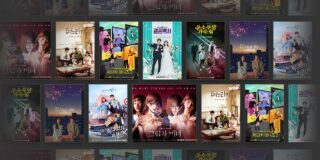Ever wonder how a Korean webtoon transforms so naturally into English? Our French, Spanish, and Chinese fans might wonder the same. If it seems like our stories have been crafted by talented writers working in their native languages, it’s because they have!
Meet “Kiwi Vine,” one of Kakao Entertainment’s subsidiaries that plays a key role to bring Korean content to fans worldwide. Some might call it “translation,” but that simply doesn’t do justice to their work. Our colleagues at Kiwi Vine begin with a deep understanding of the original content and creatively layer on local sentiment and nuance, turning everything from webtoons to web novels, films, dramas, TV series, documentaries, and animations into content local fans will immediately recognize and feel close to.
We asked the Krew at Kiwi Vine about the values that guide their localizations, and here are 7 awesome answers.
1. Expressing the author’s intent impactfully
“For me, the most important aspect of translation is to connect with the target audience so they can understand and enjoy the work in their own language,” says Matt Vitone, an English writer who has worked on webtoon titles like The Lady Needs A Break, Moving, and Touch Your Heart. “While it is important to express the author’s intent, it is also crucial to know when to make changes to the text to make it emotionally impactful for the reader and not sound stiff or unnatural. These changes may include small tweaks such as changing terms like “SNS” to more native ones like “social media,” or more significant changes like creating an entirely new title for the webtoon in English.”
2. Balancing different writing norms
Jenessa Gilley, who helped translate web novels like I Fell into a Reverse Harem Game, Revolutionary Princess Eve, and Just Leave Me Be, describes localization as being similar to painting. “Web novel translation, much like book translation, involves taking a painting made of letters, words, clauses, and paragraphs, and recreating it as faithfully as possible while preserving the beauty of the text, despite having to use entirely new materials.” She also notes, “However, Korean writing norms such as repetition, formatting, variation in sentence structure and length, and punctuation do not always align with English writing norms, making it a balancing act between retaining accuracy and creating an enjoyable, easy-to-read text.”
3. Preserving length and rhythm
“Webtoons are a short format, and the French language presents a challenge as it is typically longer than Korean,” said Camille Simone Brabant, a French writer who helped localize many works into French including MAVE: Another World, Extraordinary You, and The Legendary Moonlight Sculptor. “To provide an equivalent reading experience for French readers, we need to use creativity to convey the essence of the story while maintaining dynamic dialogues and characters. In my opinion, this extra step sets localization apart from translation, and it is our duty to both the creators and the readers to do so.”
4. Adapting to the target language
“It is not enough for the audience to merely understand the content. They should also be able to relate to and engage with it,” says Ana Manzo, a Spanish proofreader who localized Dr. Brain, The Uncanny Counter, and Itaewon Class. “What resonates with readers in one country might not be the same for another so we have to take into account the variants of the target language while maintaining accuracy and authenticity.”
5. Promoting inclusiveness
Jeesu, who has worked to localize into Korean such titles as CSI: Miami, The Wire, and Fantastic Beasts and Where to Find Them, stresses the importance of keeping abreast of the latest language trends when developing subtitles for TV shows or movies. “We aim to be inclusive in our translations, so unless it’s absolutely necessary for the context, we avoid language that offends or excludes certain genders, races, disabilities, occupations, or other groups. For instance, we usually have characters speaking to each other in Korean honorifics, regardless of gender or age. Subtitles should be respectful and inclusive to everyone.”
6. Reflecting nuanced cultural differences
“When localizing Korean webtoons for Chinese audiences, we have to balance faithfulness to the original text with readability for the audience,” said Wang Jun, who localized Misaeng, Baby Empress, and Solitary Lady. “Our goal is to accurately convey the meaning of the original text while ensuring everything reads naturally, without feeling like a translation. This means that we may need to adapt the text to the target language, even if it differs from the original form. For example, Korean often uses onomatopoeia to express the taste of food, while in Chinese, it may be more natural to use an adjective that describes the smell. We want to create translations that resonate locally, making the reading experience as enjoyable and immersive as possible.”
7. Crafting design adjustments tastefully
“For our design team, the challenge is to preserve the visual beauty and intended meaning of the source material by expertly packaging the carefully trimmed content created by the localization team with high-quality typography,” said Sumin An, a designer who worked on visuals for Overgeared, When the Villainess is in Love, and Solo Leveling. “For example, in Korean, the sound of a crash is written as ‘쾅(kwang),’ whereas in English we might need something longer like ‘KA BOOM.’ We’re always working to preserve the original flavor while making sure it resonates locally.”
James Park, Kiwi Vine’s CEO is passionate about the work his teams do to bring great Korean content to the world. He gets the last word!
“Our team of creatives come from different backgrounds, but they all share the same goal: delivering absolute quality so readers can simply immerse themselves in the story and enjoy, without ever once thinking about translation quality,” said James Park, Kiwi Vine CEO. “We are committed to expanding our language offerings to reach even more readers worldwide, and as we do, we’ll continue to nurture the multicultural team diversity that is the core of our success.”





